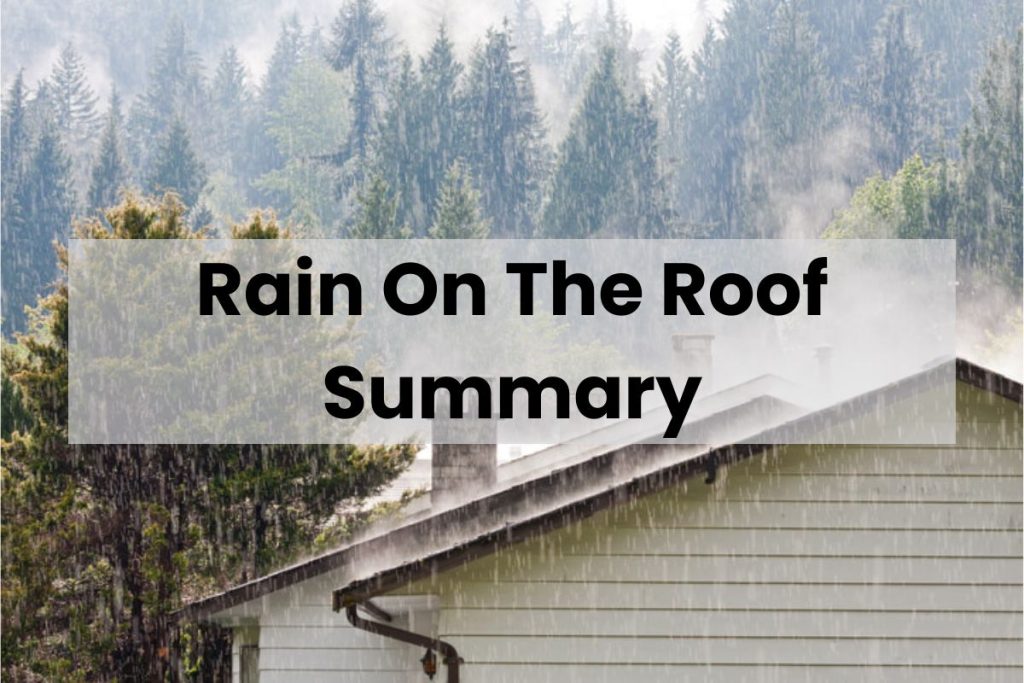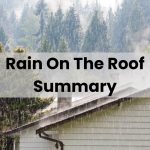Rain On The Roof Summary: The poem, “Rain On The Roof” by Coates Kinney is included in the Class IX Syllabus of Central Board of Secondary Education in the English sourcebook, “Beehive”. The students who will be appearing for the exams need to be thorough with the aspects of the poem and its analysis. The questions will be asked from the text of the poem. One of the best ways to remember the events in a chronological and organised manner is by remembering the gist. Additionally, being ready with the summary of the poem also helps in the last-minute revisions.

In the following article, we have provided a complete Rain On The Roof Summary which the students can refer to while preparing for the exam. Additionally, concepts such as theme, title, rhyming scheme, metaphors, and more have also been mentioned below for the convenience of the students.
Rain On The Roof Summary
The students who are to appear for the Class 9 Examinations of the Central Board of Secondary Education CBSE need to study the book, “Beehive” as a part of the English academic curriculum. The students need to be thorough with the poem as the questions can be asked from anywhere between the lines and the gist of the topic. While preparing, one must remember the chronological order of the events and their aspects. The questions can be asked regarding an event being held at a point in the poem or regarding literary devices. Probable questions can also be regarding the theme of the poem and its title. The students need to prepare themselves for the examination accordingly.
Rain On The Roof By Coates Kinney
When the humid shadows hover
Over all the starry spheres
And the melancholy darkness
Gently weeps in rainy tears,
What a bliss to press the pillow
Of a cottage-chamber bed
And lie listening to the patter
Of the soft rain overhead!
Every tinkle on the shingles
Has an echo in the heart;
And a thousand dreamy fancies
Into busy being start,
And a thousand recollections
Weave their air threads into woof,
As I listen to the patter
Of the rain upon the roof.
Now in memory comes my mother,
As she used in years agone,
To regard the darling dreamers
Ere, she left them till the dawn:
O! I feel her fond look on me
As I list to this refrain
Which is played upon the shingles
By the patter of the rain.
Summary of Rain On The Roof
In the poem, “Rain On The Roof”, the poet intends to talk about the memories of the past, that one can reminisce through events that are common in past and future. One such event is the falling of rain on his roof. When the raindrops fall on the roof, they make a sound that connects him to his childhood and the events in the poem unfold in a manner that through the auditory imagery, the poet is able to connect the readers to such a moment when his mother was around.
The Poem starts with the poet discussing “humid shadows” signifying rain-filled clouds and how they take over the “starry spheres” or the night sky. As the night gets sadder and darker, the clouds “weep” or shower the rain. Here, “tears” are used to reflect the idea of raindrops as the poet discusses the melancholy in his mood. He further explains that it is then that he feels content and satisfied as he gets to lie in his room and listen to the drops of the rain making a sound on the roof.
He further compares the sound of the rains to “tinkle” to express auditory imagery. He explains that every sound that is made on the roof resonates with his heartbeats and echos within. It is then, that the dreams start filling with fantasies and recollections of old days make their way to his mind. He says, “a thousand recollections weave their air threads” using the personification idea to display how these memories take the form of a dream and come into his mind as he listens to the rain falling down on the roof and making sounds.
With these recollections and the “dreamy fancies”, the memories of his mother hit him strongly. He recollects and reminisces how she passed away and left him. He explains that the memories that he is getting belong to the time when his mother was around. He further speaks of her love for him and explains that she always considered him a darling. As he listens to the sound of the falling raindrops, he recollects all the memories of his mother and feels as if she is looking at him.
The poet used numerous emotions throughout the poem making it more realistic, exploring, and expressive. As the poem and its event unfurl, there are various emotions that get painted through the poetry. The sounds move him to an extent that the past memories triggered him in a way that everything that once seemed gloomy, appeared extremely blissful as he was able to relive the moments of a good time that he had but soon the absence of his mother brings in a different emotion which is also shaded by the realisation of the enormity of her love.
What’s the theme of the ‘Rain On The Roof’ Poem?
The theme of the poem is maternal love and past memories that he connects through a very natural and normal event in life to something that reminds him of his mother. It is the sound of the raindrops that bring back a lot of memories for the poet. The poet intends to express that no matter where he is, and if his mother is alive or not, his love and longing for her shall never end. He feels and reminisces all the comfortable days in life that he used to experience as a child when his mother was around. When he was young, he used to listen and observe the sounds of raindrops falling on the roof as he does today. That memory makes him realise the sadness of the absence of his mother.
Aptness of the Title
The title, “Rain On The Roof” is like a memory lane for the poet. Here, in this poem, the rain falling on the roof and making sounds is like a correlation between his past and present, helping him to reminisce about his mother. In the poem, the rain makes such sounds that he heard in his past when his mother was around. Thus, the title is appropriate as it is the rain falling on the roof above the poet that creates a channel through which he can remember his mother and the happier past.
Literary Devices Used in the Poem
The poet has used literary devices in the poem. Some of the examples have been provided subsequently for reference:
- Rhyme Scheme: abcbdefe
- Alliteration: Now in memory comes my mother (Repetition of “M”)
- Auditory Imagery: “And lie listening to the patter Of the soft rain overhead!”
- Metaphor: In the First stanza, Darkness has been compared to the feeling of sadness
- Personification: “thousand recollections Weave their air-threads into woof”, where Thousand Recollections have been personified as someone who can weave
- Epithet: In the third stanza, the poet has used, “Dreamy Fancies”






